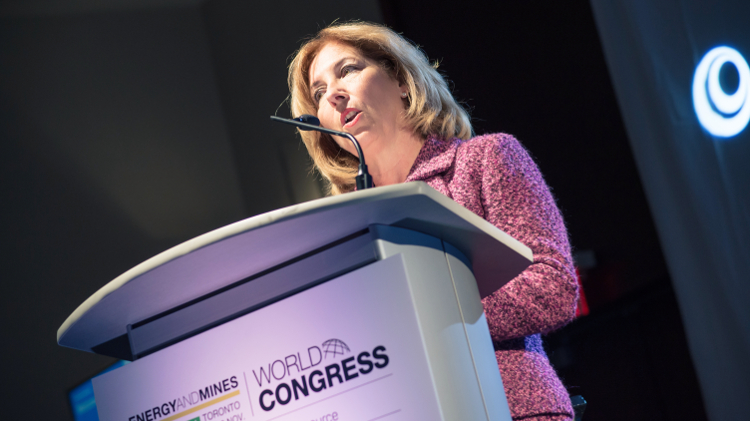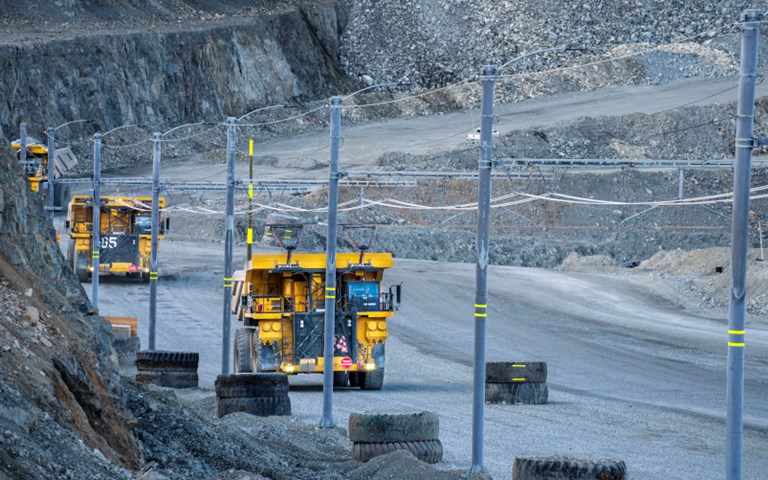In a studied section, haul trucks connected to the trolley assist system reduced their carbon dioxide equivalent per truck cycle by 79 kilograms. Courtesy of Copper Mountain Mining
In early April, seven massive haul trucks were suddenly zipping up a steep one-kilometre haul ramp of Copper Mountain Mining’s flagship open-pit mine at twice the speed – and a mere fraction of the diesel usage.
It’s the result of the new trolley assist infrastructure at the southern British Columbia copper mine. A trolley assist system enables electric-motor haul trucks to bypass their diesel generators and receive clean power directly from the overhead power line. While going up the ramp, the truck’s engine is idle – still technically running, but not consuming nearly the same amount of fuel. Copper Mountain worked with ABB on the power infrastructure, with SMS Equipment and Komatsu on the haul trucks, and received some funding for the project from Clean BC and B.C. Hydro.
The trolley assist system will play a key role in helping Copper Mountain reach its ambitious goal of net-zero carbon emissions by 2035. Gil Clausen, Copper Mountain’s president and chief executive officer, said he and chief operating officer Don Strickland quickly pinpointed the site’s diesel-generated haul trucks as its largest source of emissions.
“We started putting together this [emissions reduction] plan and trolley assist became a big part of it,” Clausen said. “How do we lay the groundwork for the future? We have to take away the highest energy-consumptive part now, which is haulage uphill.”
Only a few months in, the pilot phase has already been a major success. According to Clausen, the pantograph-equipped haul trucks climb the mine’s toughest haul ramp at more than twice the speed of the company’s regular trucks, and at one-twelfth the diesel cost. The company also completed a study that estimates it is cutting 79 kilograms of carbon dioxide equivalent per truck cycle on the installed trolley section, and it expects trolley assist will help it slash its overall emissions by at least 30 per cent.
The project represents a major milestone for the industry: Copper Mountain is the first open-pit mine in North America to install trolley assist, though the technology has been available for decades. Clausen said he thinks it may also mark a turning point as mining companies seek to rapidly decarbonize to reach net-zero emissions.
“I think there’s a real opportunity here for this technology to become much more pervasive in our industry,” he said. “So we’re trying to stay one step ahead of the game. We’re assuming the trolley assist will be a successful test, we have a strong sense that it will, and we’re working on the next phase of evolution of haulage here that’s going to get these large haul trucks to carbon zero.”
Powering ahead
Copper Mountain first started discussions about implementing trolley assist in 2019, and launched a feasibility study looking at what electrical infrastructure would be necessary, how to outfit the trucks and the quality of mine haul road necessary for a successful implementation. By late 2020, the study showed “positive results” and the company and its partners decided to power ahead, said George Shehata, project development for process industries at ABB.
The company is starting with seven trucks, outfitted with pantographs that connect to the trolley assist infrastructure, with plans to eventually expand the number of trucks capable of using the system. Shehata noted Copper Mountain had a built-in advantage: it already owned haul trucks with electric drive motors, which require less modification than introducing a trolley assist system with only traditional diesel-powered trucks.
The trial is taking place on the haul ramp that will see the majority of Copper Mountain’s ore transport for the next 10 to 15 years, making it a logical choice, Clausen said. He also noted the ramp is the mine’s toughest duty cycle, at a 10 per cent incline, and one of the most energy-intensive stretches of road on site. While the trolley assist saw less action in the summer months as Copper Mountain developed some of the open pit’s upper benches, Clausen said the company is heading into a period of heavy testing this fall.
Within the first few months, the company “knocked some of the bugs out,” Clausen said. The truck’s pantographs are exposed to the risk of falling rock from the loading operations above, causing a potential maintenance issue, and needed to be made more robust. With the modifications, he said, the company has been able to maintain high availability of the trolley-assisted trucks.
Clausen noted it has also been crucial to keep the haul road smooth and level so the pantographs stay properly connected to the overhead wires.
A slow climb
Trolley-assist technology has long been available. During the 1970s energy crisis, when the Yom-Kippur War in 1973 and the 1979 Iranian Revolution disrupted oil supplies, creating shortages and price spikes for western countries that relied on energy exports from the Middle East, numerous mining companies commissioned studies on trolley assist as they sought to reduce their diesel reliance.
Even though trolley assist is a win-win, speeding up cycle times and improving productivity while slashing emissions, the technology never quite took off. To date, according to ABB, there have been some installations at African mines. Eldorado Gold partnered with Hitachi Construction Machinery in 2012 to install trolley assist at its Kışladağ mine in Turkey.
Most recently, in 2018 Swedish miner Boliden worked with ABB to introduce trolley assist infrastructure at its Aitik copper mine in northern Sweden to power four mine trucks over a 700-metre stretch of haul road, which saved the mine 830,000 litres of diesel per year. The company spent US$31.2 million in 2020 and 2021 to install an extra three kilometres of trolley line and convert 10 additional trucks at Aitik, as well as to install 1.8 kilometres of road and convert 13 trucks at its Kevitsa nickel mine in Lapland, Finland. Boliden has said trolley assist can cut its transportation-related GHG emissions by 80 per cent along the routes where the technology is implemented.
Sachin Jari, general manager of mining North America at ABB, said there are numerous reasons why trolley assist hasn’t reached widespread adoption. After the energy crisis, the cost of diesel has been historically lower than it is today, and until recently there was no urgency within the industry to reduce the environmental footprint of mining. He noted that electric drive train technologies for haul trucks and power technology have also evolved significantly in the past decades.
Jari said ABB conducted its first study of trolley assist with a copper mining company roughly five years ago, and at the time, the business case didn’t make sense. “With today’s conditions, it makes business sense, as well as sense on the human side,” he said.
Since Copper Mountain commissioned the system in April, Clausen said his team has been giving tours regularly to other companies that want to understand how the system works. Jari and Shehata also said ABB has seen an influx of inquiries.
There are a few key elements that need to be in place for trolley assist to be a viable option with a reasonable payback period, Shehata said, with the longevity of the haul roads being among the most important. If a mine plan builds in regular changes to the haul road, it becomes harder to justify installing the trolley-assist infrastructure. The stretch of road where trolley assist is installed also needs to be a decently steep incline, he said, to result in meaningful fuel cost and usage savings. The mine also needs to have an available clean power source at a reasonable cost; operations that are drawing on on-site diesel generated electric power won’t make much of a dent in their GHG emissions by switching from one carbon-emitting power source to another.
At Boliden’s Aitik and Copper Mountain, environmental conditions were a factor in designing the electrical infrastructure, Shehata said. The pantographs and overhead electrical work had to be built to withstand the cold winters in both Sweden and B.C.
Getting ambitious
Copper Mountain hasn’t technically finished its pilot period yet, but Clausen is already looking to the future. He said the company hopes to move to the “next phase” of the technology by purchasing battery-electric haul trucks once those are available and using the trolley infrastructure to charge them.
One of the sticking points around battery-electric haul trucks for open pits has been the size of battery needed to power a large machine for the long duty cycles required, Clausen noted. “It’s hard to get a battery size that’s efficient enough to run a full production shift and recharge between shifts,” he said. Trolley assist could close that gap, allowing a smaller battery to be continuously used by charging it during the duty cycle.
The company has also been evaluating trolley, truck and conveyor options – the latter of which would be all-electric – for its New Ingerbelle deposit, which Clausen said will be announced in the updated feasibility study and new life-of-mine plan released in the third quarter of this year. New Ingerbelle, which will eventually supplant Copper Mountain, is located roughly one kilometre away.
Clausen said going all in on trolley assist was due to the sense of “urgency” the company feels about meeting net-zero goals. Copper Mountain wants to work with others and share what it is learning to get the industry to move more quickly towards decarbonization, he added.
“Everyone has concepts of getting to carbon neutral by 2050, but there’s a much greater sense of urgency that we have to have. We can’t afford to miss these goals, there’s too much at stake not to be successful,” he said. “We’ve got to take action, and the only way to do that is tangible plans and putting the energy and resources behind them. If you don’t do that, you’re selling everybody else short.”
Net-Zero Challenge will run throughout 2022. It will examine the challenges involved with reducing greenhouse gases and eliminating carbon footprints, and it will also look at the opportunities those actions can represent. If you have something to contribute, reach out to us at editor@cim.org.
PROUDLY SPONSORED BY






